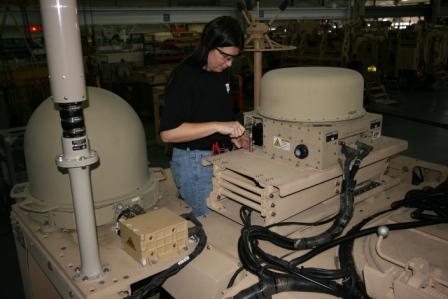
By Katie E. Cain
In preparation for Network Integration Evaluation (NIE) 12.2, the third in a series of semiannual evaluations designed to holistically integrate and rapidly advance the Army’s tactical network, the U.S. Army Tank Automotive Research, Development, and Engineering Center (TARDEC) is spearheading key ground vehicle integration efforts from its headquarters in Warren, MI.
This marks the first time the Detroit Arsenal has conducted vehicle integration in support of the NIE. During the first two exercises, NIE 11.2 and 12.1 in the spring and fall of 2011, respectively, the systems that underwent testing and evaluation were integrated into the Army’s combat vehicle fleet at Fort Bliss, TX, and White Sands Missile Range, NM, where the 3,800 Soldiers of the 2nd Brigade Combat Team, 1st Armored Division (2/1 AD) carry out the evaluations. The work was moved to the Detroit Arsenal to ensure that all vehicle integration, verification, and design work was completed upfront before the equipment arrived at Fort Bliss for integration with the gaining unit.
“TARDEC’s previous work on network integration projects positioned us well in receiving this work,” said Kirndeep Bhamra, Deputy Associate Director, Project Management at TARDEC’s Center for Ground Vehicle Development and Integration (CGVDI). “We’ve led many projects, including Digital Backbone and command and control on-the-move integration. This prior relationship with PEO C3T [Program Executive Office Command, Control, and Communications – Tactical], coupled with our core mission of managing systems development and integration projects, made us the best choice to lead this effort.”
A key part of the effort is integrating equipment for Warfighter Information Network – Tactical (WIN-T) Increment 2, the Army’s on-the-move, satellite-based communications network, into various Mine Resistant Ambush Protected All-Terrain Vehicles (M-ATVs).
“There were various components that needed to be integrated into the M-ATVs, taking into consideration space, weight, power, thermal impacts, safety, mobility, and various other analyses,” Bharma explained. “CGVDI is the overall project lead for this work. We designed the brackets to hold the equipment and integrated three prototype vehicles (mechanical and electrical).”
Additionally, CGVDI helped procure production kits in support of NIE, leveraging various TARDEC resource groups for electrical design, software, and supporting analyses.
WIN-T Increment 2 is designed to extend satellite communications down to the company level, allowing Soldiers to communicate through voice, data, images, and video, even in complex terrain that can break line-of-sight radio connections. In conjunction with NIE 12.2, WIN-T Increment 2 will undergo its initial operational test and evaluation in May and June.
- KATIE E. CAIN is a Media Relations Specialist for the Tolliver Group Inc., supporting the Assistant Secretary of the Army for Acquisition, Logistics, and Technology System of Systems Integration Directorate. Cain holds a B.A. in applied arts in integrative public relations, with a concentration in political science, from Central Michigan University.







